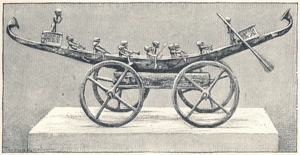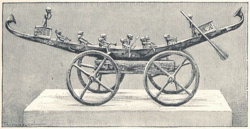كاموس
| كاموس Kamose | ||||||||||||||||||||||||||||||||||||||||||||||||||||||||
|---|---|---|---|---|---|---|---|---|---|---|---|---|---|---|---|---|---|---|---|---|---|---|---|---|---|---|---|---|---|---|---|---|---|---|---|---|---|---|---|---|---|---|---|---|---|---|---|---|---|---|---|---|---|---|---|---|
 Illustration of a votive barque attributed to Kamose | ||||||||||||||||||||||||||||||||||||||||||||||||||||||||
| فرعون | ||||||||||||||||||||||||||||||||||||||||||||||||||||||||
| الحكم | 1554-1549 ق.م. (السابعة عشر) | |||||||||||||||||||||||||||||||||||||||||||||||||||||||
| سبقه | Tao II the Brave | |||||||||||||||||||||||||||||||||||||||||||||||||||||||
| تبعه | أحمس الأول | |||||||||||||||||||||||||||||||||||||||||||||||||||||||
| ||||||||||||||||||||||||||||||||||||||||||||||||||||||||
| الأنجال | Sitkamose (?) | |||||||||||||||||||||||||||||||||||||||||||||||||||||||
| الأب | سقنن رع تاعا الثاني | |||||||||||||||||||||||||||||||||||||||||||||||||||||||
| الأم | Ahhotep I | |||||||||||||||||||||||||||||||||||||||||||||||||||||||
| توفي | 1549 ق.م. | |||||||||||||||||||||||||||||||||||||||||||||||||||||||
| كاموس بالهيروغليفية | ||||||||||||||||
|---|---|---|---|---|---|---|---|---|---|---|---|---|---|---|---|---|
| Kamose's three Horus names | ||||||||||||||||
Nfr-ẖ3b-t3wj The perfect horus who tames the two lands [3] | ||||||||||||||||
Ḫˁj-ḥr-nst=f He who appears on his throne | ||||||||||||||||
Sḏf3-t3wj He who nourishes the two lands[4] | ||||||||||||||||
كاموس Kamose، كان آخر فراعنة الأسرة السابعة عشرة في مصر القديمة، واستمر حكمه مدة ثلاث سنوات على الأقل (1541 - 1539 ق.م..). وهو ابن الملك سقنن رع تاعا الثاني وأمه الملكة إياح حتب وأخ الملك أحمس الأول.
الحملات
سبب الحرب
Kamose was the final king in a succession of kings of increasing power. Originally, the Theban seventeenth dynasty probably was just a group of local governors or Nomarchs, but after the reign of Intef VII and Seqenenre Tao II, Thebes had become dominant over Upper Egypt[5] and ruled Middle Egypt as far as Cusae.[6] Kamose sought to extend his rule northward over all of Lower Egypt. This apparently was met with much opposition by his courtiers. It appears that at some point, these princes in Thebes had achieved a practical modus vivendi with the later Hyksos rulers, which included transit lefts through Hyksos-controlled Middle and Lower Egypt and pasturage lefts in the fertile Delta.[7] His records on the Carnarvon Tablet relate the misgivings of Kamose's council to the prospect of losing all that:
See, all are loyal as far as Cusae. We are tranquil in our part of Egypt. Elephantine [at the First Cataract] is strong, and the middle part (of the land) is with us as far as Cusae. Men till for us the finest of their lands. Our cattle pasture in the Papyrus marshes. Corn is sent for our swine. Our cattle are not taken away... He holds the land of the Asiatics; we hold Egypt..."[8]
Kamose appears to have been much more concerned with prestige than with economics, and sought to regain by force what he thought was his by left, namely, the kingship of Lower and Upper Egypt.[9] The king thus responds:
I should like to know what serves this strength of mine, when a chieftain in Avaris, and another in Cush, and I sit united with an Asiatic and a Nubian, each in possession of his slice of Egypt, and I cannot pass by him as far as Memphis... No man can settle down, when despoiled by the taxes of the Asiatics. I will grapple with him, that I may rip open his belly! My wish is to save Egypt and to smite the Asiatic!"[10]
There is no evidence to support Pierre Montet's assertion that Kamose's move against the Hyksos was sponsored by the priesthood of Amun as an attack against the Seth-worshippers in the north (i.e., a religious motive for the war of liberation). The Carnarvon Tablet does state that Kamose went north to attack the Hyksos by the command of Amun, but this is simple hyperbole, common to virtually all royal inscriptions of Egyptian history, and should not be understood as the specific command from this deity. Kamose states his reasons for an attack on the Hyksos was nationalistic pride. He also may have merely continued carrying out the aggressive military policies of his immediate predecessor, Seqenenre, his father, who apparently had died in battle against the Hyksos.
الحملة الشمالية
خاض غمار حرب التحرير ضد الهكسوس خلال العام الثالث من حكمه، واستولى على مدينة "نفروسي Nefrousy" التي كان يحكمها أحد عملاء العدو، وتقدم بجيشه إلى أطراف "أڤاريس"، لكنه لم يستولي عليها. فقد شعر بالخطر الداهم يهدد مؤخرة جيشه بسب هجمات أمير "كوش" الذي كان قد انضم إلى "أبوفيس" ملك الهكسوس، وكان أمير كوش يضمر لكامس بعض الضغينة لقيامه بغزو الأراضي النوبية والإستيلاء على بوهن.[11]
حملة النوبة الأولى
Kamose is known to have campaigned against the Kushites prior to his third year since the Hyksos king directly appeals to his Kushite counterpart to attack his Theban rival and avenge the damage which Kamose had inflicted upon both their states. It is unlikely that Kamose had the resources, simultaneously, to defeat the Kushites to the south and then, inflict a serious setback on the Hyksos to the north in just one year over a front-line that extended over several hundred kilometres.[12]
مدة الحكم
تولى الحكم بعد موت أباه سقنن رع تاعا الثاني حوالي عام 1545 ق.م. دعته امه الملكة إياح حتب ليستكمل حرب أبيه مع الهكسوس. وقد عثر في عام 1954م على لوحتبن أقيمتا في الكرنك لتمجيد انتصارات الملك كاموس على أبوفيس ملك الهكسوس وتتحدث إحدى هاتين الوحتين عن انتصار كاموس في أواريس عاصمة الهكسوس في الدلتا وتفاصيل الإستراتيجية التي اتبعها وعودته منتصرا إلى طيبة.
تابوت الملك كاموس
توفى كامس في أثناء حربه مع الهكسوس عام 1540 ق.م. على مشارف مدينة (امبوس) بعد أن كان داخلها منتصرا مظفرا جاءته ضربة الغدر من أحد جرحى الهكسوس فوافته المنية وآخر ما نطق به أن وصى أخوه أحمس أن يبلغ الجده العظيمة توتيشيري انه لحق أباه ومات ميتة سقنن رع.
ذكرت مقبرة كامس في بردية أبوت حيث يذكر انه تم نقل تابوت كامس من مقبرته ودفن في ذراع أبو النجا خوفا عليه من اللصوص في عصر رمسيس الرابع حيث اكتشفه مريت في ديسمبر عام 1857 م تحت كومة من التراب، وذكر مريت أن المومياء كانت في حالة سيئة جدا، وقد وجد مع المومياء خنجر من الذهب والفضة، ومرآه من البرونز، وبردية مجدولة على أعلى ذراع كامس، كما وجد أيضا جعران وبعض التعاويذ، وقد ظل الكفن في مصر بينما يوجد الخنجر في متحف بروكسل ببلجيكا، والمرآه في متحف اللوڤر.
المصادر
- ^ Clayton, op. cit., p.94
- ^ Clayton, Peter. Chronicle of the Pharaohs, Thames and Hudson Ltd, paperback 2006. p.94
- ^ Claude Vandersleyen: L'Egypte et la vallée du Nil. Tome 2: De la fin de l'Ancien Empire à la fin du Nouvel Empire.Paris 1995, S. 195
- ^ Friedrich Wilhelm von Bissing: Ein thebanischer Grabfund aus dem Anfang des Neuen Reiches. Tafel 4 (8)
- ^ Grimal, Nicolas. A History of Ancient Egypt. p.189. Librairie Arthéme Fayard, 1988.
- ^ James, T.G.H. Egypt: From the Expulsion of the Hyksos to Amenophis I. in The Cambridge Ancient History, vol. 2, part 1, ed. Edwards, I.E.S, et al. p. 290. Cambridge University Press, 1965.
- ^ "Cambridge 2:1 290"
- ^ Gardiner, Sir Alan. Egypt of the Pharaohs, Oxford: University Press, (1961), p.166"
- ^ "Cambridge 2:1 290"
- ^ Gardiner, Sir Alan. Egypt of the Pharaohs, 1961, reprint Oxford University Press, 1979, p.166
- ^ پاسكال ڤيرنوس (1999). موسوعة الفراعنة. دار الفكر.
{{cite book}}: Unknown parameter|coauthors=ignored (|author=suggested) (help) - ^ Ryholt, Kim SB. op. cit., pp.182-83
قائمة المراجع
- Gardiner, Sir Alan. Egypt of the Pharaohs. Oxford: University Press, 1964, 1961.
- Montet, Pierre. Eternal Egypt, translated from the French by Doreen Weightman. London, 1964
- Pritchard, James B. (Editor). Ancient Near Eastern Texts Relating to the Old Testament (3rd edition). Princeton, 1969.
- Redford, Donald B. History and Chronology of the Eighteenth Dynasty of Egypt: Seven Studies. Toronto, 1967.
- Ryholt, Kim SB, The Political Situation in Egypt during the Second Intermediate Period (Carsten Niebuhr Institute Publications, Copenhagen, (Museum Tusculanum Press:1997) ISBN 87-7289-421-0
| سبقه تاعا الثاني الشجاع |
فرعون الأسرة السابعة عشر |
تبعه أحمس الأول |


